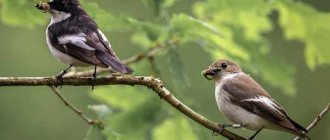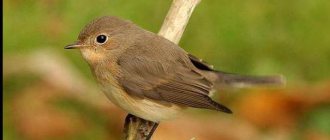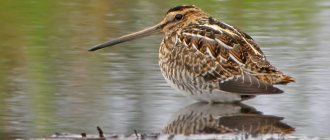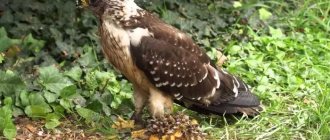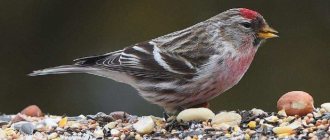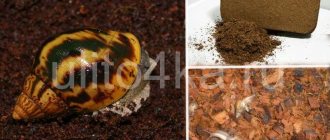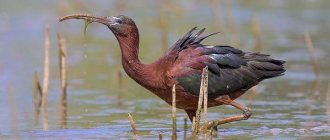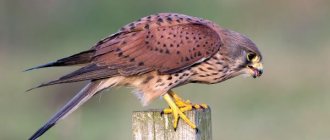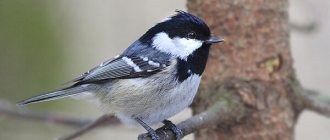Types of flycatchers
These birds belong to the passerine order and number up to 300 species worldwide, of which only fifteen can be found in Russia. The most common are the small flycatcher, the gray flycatcher and the pied flycatcher. They are migratory birds that spend the winter in Africa and South Asia.
Small birds, whose weight does not exceed 25 grams, differ mainly in the color of their plumage. All flycatchers have a wide beak, on which the upper beak ridge is clearly visible. Near the base of the beak and along the edges there are elastic bristles, which in some species even cover the nostrils. They help birds catch insects on the fly. The wings are not wide, but quite long.
The appearance of chicks
In June, eggs appear in the nest, of which there are usually no more than six. The shell is colored bluish interspersed with dark shades. The female incubates the eggs herself for two weeks. Egg dimensions 19 x 14 mm. Sensing danger, the birds fly around the nest with restless cries, sometimes they can even imitate an attack on an uninvited guest who is trying to inspect the nest, swooping down on it, curling up right next to its face.
Both parents feed the chicks. The offspring grow very quickly, and by the age of one month they become independent. And during this time the parents manage to make a second clutch.
Gray flycatcher
These birds differ from their relatives in the most modest and inconspicuous coloring - the upper part of the body is grayish-brown, and the lower part is light gray with small inclusions. The gray flycatcher is a fairly small bird, rarely larger than a sparrow. Their singing can be heard very rarely; it is very simple, like the bird itself.
It sits vertically on a branch, often fluttering its wings as if about to take off, and vigilantly watches insects flying nearby. Quickly taking off, she pursues her prey in the air.
It nests mainly in the forest, especially where there is a lot of dead wood and broken trees, preferring sunny edges and clearings. This bird is not known for its secrecy, and quite often it can be found in parks, squares, and near country houses. Their discreet, modest appearance allows these birds to remain unnoticed and safely raise their offspring almost next to human habitation.
The gray flycatcher is a bird that starts building a nest quite late, as it arrives only in mid-May. Only the female is involved in the construction, using plant fibers, straw and dry grass. The litter in the nest is usually very sparse and consists of feathers and wool. In June, a clutch appears consisting of 4–6 greenish eggs covered with specks.
Nutrition
The small flycatcher is not at all picky about food. According to ornithologists, these little ones eat everything that can fit into their miniature beak. The food of the small flycatcher largely depends on weather conditions: on a fine clear day, these birds catch flies, small butterflies, and dragonflies. A flycatcher will not refuse a horsefly that has flown into its hunting grounds.
In bad weather, when it is impossible to fly, the bird feeds on caterpillars, small bugs and other insects that hide from the rain in the foliage of trees. Our heroine also takes shelter from the rain there. Flycatchers hunt for almost all insects in the air, however, they do not ignore creeping species.
It is interesting that the flycatcher can deftly lift fallen leaves with its beak and under it it will definitely find some food for itself. These could be spiders, ants, small bugs, etc.
Pied Flycatcher
The male pied is slightly different in appearance from the female. The color of its plumage is contrasting, black and white, which makes the bird look like a small magpie - black back, white belly, white spots on the forehead and wings. The plumage of the female is more modest and inconspicuous, consisting of gray-brown shades. The Pied Flycatcher is an omnivorous bird.
Trust in people allows these birds to build their nests in public gardens and parks, where there are a lot of people. Arriving in early spring, the pied bird nests in hollows and crevices of trees, and willingly settles in artificial nests. The clutch usually consists of 5–7 bluish eggs. The incubation period takes approximately two weeks.
Little flycatcher
The bird is very similar to the robin, except for the white spots on the tail, clearly visible during flight. Compared to the gray flycatcher and pied flycatcher, the main distinguishing feature is the red spot on the chest, especially large and bright in adult males. And, of course, significantly smaller dimensions - the body of this bird does not exceed 10 cm in length, and its weight is only 11 grams.
The singing of the Little Flycatcher is difficult to confuse with the voices of other birds. Her anxious whistling has a sad and even mournful character. It nests mainly in shaded high-trunk forests, usually in spruce or spruce-deciduous forests, where there are more dense thickets. Despite its small size, the bird occupies a nesting area much larger than that of other flycatcher species; as a rule, it is about 300 meters.
Once a year, the female lays from four to six whitish eggs with small rusty specks, from which chicks covered with gray fluff emerge 14 days later. Having grown stronger and having flown out of the nest, they remain nearby for some time. The Little Flycatcher is the rarest bird among all the above species.
Diptera insects (houseflies, gadflies, horseflies, etc.) give people and animals many unpleasant sensations. And, perhaps, their most terrible enemy, which means our friend, is a small bird called a flycatcher.
2. In any garden or summer cottage there is a flycatcher - a small and inconspicuous bird. Despite its long-standing proximity to humans, not much is known about it.
3. Flycatchers eat basically any insects - butterflies, beetles, dragonflies, but their favorite ones are, of course, flies; they are the ones she constantly hunts for.
4.Flycatchers number up to 300 species around the world, of which only 15 can be found in Russia. The most common are the small flycatcher, the gray flycatcher and the pied flycatcher.
5. Flycatchers are small birds whose weight does not exceed 25 grams; they differ mainly in the color of their plumage. Flycatchers are migratory birds that spend the winter in Africa and South Asia.
6. All flycatchers have a wide beak, on which the upper beak ridge is clearly visible. Near the base of the beak and along the edges there are elastic bristles, which in some species even cover the nostrils. They help birds catch insects on the fly. The wings are not wide, but quite long.
Gray flycatcher
7. Gray flycatchers differ from their relatives in the most modest and inconspicuous coloring - the upper part of the body is grayish-brown, and the lower part is light gray with small inclusions.
8. The gray flycatcher is a fairly small bird, rarely larger than a sparrow. Their singing can be heard very rarely; it is very simple, like the bird itself. It sits vertically on a branch, often fluttering its wings as if about to take off, and vigilantly watches insects flying nearby. Quickly taking off, she pursues her prey in the air.
9. The gray flycatcher nests mainly in the forest, especially where there is a lot of dead wood and broken trees, preferring sunny edges and clearings. This bird is not known for its secrecy, and quite often it can be found in parks, squares, and near country houses.
10.The discreet, modest appearance allows these birds to remain unnoticed and safely raise their offspring almost next to human habitation.
11. The gray flycatcher is a bird that starts building a nest quite late, as it arrives only in mid-May. Only the female is involved in the construction, using plant fibers, straw and dry grass. The litter in the nest is usually very sparse and consists of feathers and wool. In June, a clutch appears consisting of 4–6 greenish eggs covered with specks.
Pied Flycatcher
12. The pied flycatcher is an omnivorous bird. Trust in people allows these birds to build their nests in public gardens and parks, where there are a lot of people. Arriving in early spring, the pied bird nests in hollows and crevices of trees, and willingly settles in artificial nests.
13. The male pied is somewhat different in appearance from the female. The color of its plumage is contrasting, black and white, which makes the bird look like a small magpie - black back, white belly, white spots on the forehead and wings. The plumage of the female is more modest and inconspicuous, consisting of gray-brown shades.
14.The clutch of this type of flycatcher usually consists of 5–7 bluish eggs. The incubation period takes approximately two weeks.
Little flycatcher
15. The Little Flycatcher is very similar to the Robin, except for the white spots on the tail, clearly visible during flight.
16. Compared to the gray flycatcher and pied flycatcher, the main distinguishing feature is the red spot on the chest, especially large and bright in adult males.
17.And, of course, significantly smaller dimensions - the body of this bird does not exceed 10 centimeters in length, and its weight is only 11 grams.
18. The singing of the little flycatcher is difficult to confuse with the voices of other birds. Her anxious whistling has a sad and even mournful character.
19. It nests mainly in shaded high-trunk forests, usually in spruce or spruce-deciduous forests, where there are more dense thickets. Despite its small size, the bird occupies a nesting area much larger than that of other flycatcher species; as a rule, it is about 300 meters.
20. Once a year, the female lays from 4 to 6 whitish eggs with small rusty specks, from which chicks covered with gray fluff emerge 14 days later. Having grown stronger and having flown out of the nest, they remain nearby for some time.
21. The Little Flycatcher is the rarest bird among all the above species.
22. A flycatcher can sit motionless in ambush among the branches for a long time, sharply rushing after a flying insect, grabbing it in flight, then returning to its place again.
23. The method of hunting for insects forces these birds to stay alone.
24. The composition of flycatcher food depends on many conditions: the weather, time of day, lighting, that is, everything that affects the activity of insects. As a rule, on clear, warm days, the main food for flycatchers are flies, horseflies, and dragonflies.
25. In rainy weather, caterpillars, larvae, beetles and spiders hiding on the branches and leaves of trees serve as food.
26. During the nesting period of flycatchers, the male very jealously guards his territory, sings loudly, attracting the female. Both parents usually build the nest, with the exception of the gray flycatcher.
27. A flycatcher can nest very close to a person: under the roofs of houses, on lamp posts, in gardens. This bird will not refuse to live in the abandoned nests of other birds.
28.The mating season of these birds is interesting: the male flycatcher finds an empty hollow, settles down next to it and begins to perform mating serenades. Hearing love trills, the female flies to her “groom”. But there are also small overlaps, when the male manages to occupy not one, but several empty hollows.
29. Then he lures the “brides” first to one dwelling, then flies to the next, where he also emits wedding trills and the next female flies to him.
30. Thus, the male flycatcher becomes the owner of a “harem”. But we must give him his due: the male fulfills the role of father and head of the family with full responsibility. During nesting, he protects the nest and his offspring. The male helps the females feed and care for the yellow-throated chicks. To do this, a father with many children flies from one nest to another.
31. The benefits that flycatchers bring by destroying insects are undeniable. Up to 500 times a day, a pair of flycatchers has to fly to the nest with food in its beak to feed its chicks.
32. Over the entire feeding period, which lasts on average two weeks, flycatchers destroy up to one and a half million insects. By weight this is approximately 1.5 kilograms.
White-necked Flycatcher
33. The habitats of flycatchers are forest edges, small forests, and bushes.
34. Flycatchers are found throughout Europe, as well as in the Urals, Siberia, the Caucasus, South and Central Asia and Africa. Everywhere (with the exception of the southernmost ranges) these birds are migratory.
35. In August or September, they go to Africa, Syria, Iraq, Jordan, Pakistan and India for the winter.
36. In Russia, the small flycatcher nests north of the Leningrad region. In the south it is found up to the borders of the treeless steppe parts of Ukraine and in the Lower Volga region.
37. In small flycatchers, the open nest (not a hollow) usually has the shape of a small bowl. It does not exceed 50 millimeters in diameter and 45 millimeters in depth.
38. It is difficult to detect the nest of a small flycatcher, since it is well camouflaged, and the birds are very careful and stay in the upper branches of trees.
39. During nesting, sensing danger, these birds fly around the nest with restless cries, sometimes they can even imitate an attack on an uninvited guest who is trying to inspect the nest, swooping down on it, curling up right next to its face.
40.The first plumage of the chicks is brownish-brown on top with light buffy spots on the feathers. The craw, throat and upper part of the breast are pale buff with a scaly brown pattern. Its intensity decreases in the upper part of the abdomen. On its lower part the drawing is completely absent. The lower tail coverts are white.
Blackbird flycatcher - pitohu
41. Currently, 6 species of blackbird flycatchers (lat. Pitohui) are known to live in Papua New Guinea.
42.The omnivorous, brightly colored birds are endemic to the island and feed on a particular species of beetle that is believed to be the source of a powerful neurotoxin. In particular, the skin and feathers of the bicolored blackbird flycatcher (bicolored pitohu) are the main source of the toxin.
43. These amazing birds with orange and black feathers are the only birds among 9,200 bird species whose plumage, skin and flesh are riddled with batrachotoxin, which is hundreds of times more toxic than strychnine.
44. Biologists have concluded that the toxin serves to protect thrush flycatchers from natural predators, including snakes and some marsupials.
45. Adult flycatchers molt twice a year: completely during the pre-nuptial period at wintering sites and during the post-nuptial period at nesting sites.
Paradise flycatcher
46. One of the rarest flycatchers is the paradise flycatcher; it is even listed in the Red Book of Russia.
47. Back in the 60s of the last century, the small flycatcher was considered very rare in the Central Black Earth Region, but today it has become a common inhabitant of protected forests.
48. Moreover, the small flycatcher is a bird that now feels quite comfortable in city parks. In recent years, this gray bird has begun to settle on city streets.
49. Flycatchers hunt for almost all insects in the air, however, they do not ignore creeping species. It is interesting that the flycatcher can deftly lift fallen leaves with its beak and under it it will definitely find some food for itself. These could be spiders, ants, small bugs, etc.
50. Considering that flycatchers are practically not afraid of humans, anyone can build a flycatcher a house similar to a birdhouse, which we have been able to build for starlings since childhood. You will do a very useful thing, not only for the flycatcher, but also for yourself.
photo from the Internet
Habitats
Flycatchers are found throughout Europe, as well as in the Urals, Siberia, the Caucasus, South and Central Asia and Africa. Everywhere (with the exception of the southernmost ranges) these birds are migratory. In August or September they go to winter in Africa, Syria, Iraq, Jordan, Pakistan and India.
The habitats of flycatchers are forest edges, small forests, and bushes.
Mechanical methods of struggle
Mechanical methods include sticky traps, vacuuming, pressing, and trapping.
By the way, sticky traps are not very effective against flycatchers. They will simply leave a few of their legs on the Velcro and run away, and after a while they will grow new legs.
It's best if you just catch the centipede in a jar and take it outside.
Features of behavior
The method of hunting for insects forces these birds to stay alone. A flycatcher can sit motionless in ambush among the branches for a long time, sharply rushing after a flying insect, grabbing it in flight, then returning to its place again.
During the nesting period, the male very jealously guards his territory, singing loudly to attract the female. Both parents usually build the nest, with the exception of the gray flycatcher (the bird described above).
Up to 500 times a day, a pair of flycatchers has to fly to the nest with food in its beak to feed its chicks. Over the entire feeding period, which lasts an average of two weeks, flycatchers destroy up to one and a half million insects. By weight this is approximately 1.5 kilograms. The benefits that a flycatcher brings by destroying insects are undeniable.
Character and lifestyle
Flycatchers live up to their name because they are very good fly catchers. Birds hunt in a unique way: the bird takes a convenient place on a branch so that the foliage covers it and periodically jumps up, grabs a fly flying by and returns back to ambush. It should be noted that flycatchers do not only catch flies.
The small flycatcher is a master of aerial hunting and, perhaps, has no equal in this. This bird is agile, active, nimble, in general, very mobile. But the singer from the gray flycatcher is unimportant.
Nature did not endow this bird with an excellent voice. The bird's singing is more like a clatter, and sometimes the flycatcher can chirp. The male usually chirps during the mating period, while he taps his sides with his wings.
Listen to the voice of the flycatcher bird
The trills of the small flycatcher are more gentle and sonorous. The melody is a little reminiscent of a fusion of vaguely distinguishable drawn-out syllables, something like “hill-li, hill-li.”
